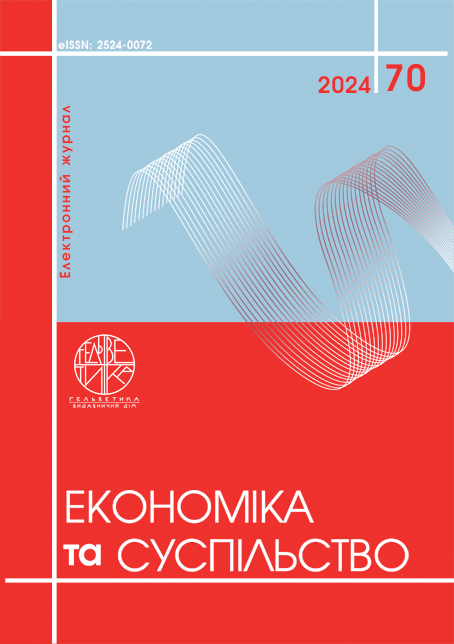ANALYTICAL ASPECTS OF THE TRENDS AND STRUCTURE OF THE POPULATION'S INCOME UNDER CRISIS CONDITIONS
Abstract
The article is devoted to the analysis of general trends and their analytics regarding the study of the structure of population incomes in conditions of instability and crisis phenomena. A theoretical analysis has been conducted to determine the structure of population incomes, and a comprehensive analysis of trends and the structure of population incomes in crisis conditions. The study of the factors influencing the structure of the population's income becomes the most important in the conditions of significant fluctuations of the economy at the national level. The tasks accomplished in this article are as follows: the categories and economic essence of household incomes are analysed; the functions and sources of income are identified; the structure of household expenditures is analysed; and an analysis of the income of the population of Ukraine is conducted. The study emphasises that the formation and regulation of the population's income is a key element of the state's socio-economic policy, especially its financial component. The adaptation of the financial system to crisis conditions, the implementation of innovative income management strategies and targeted measures to support vulnerable population groups are a necessary condition for ensuring economic stability and social balance. Particular attention is paid to the theoretical and practical aspects of income, including factor and non-factor sources, as well as their impact on the overall welfare of the population. Empirical data demonstrate that the war in Ukraine has significantly affected the material conditions of the population, increasing the proportion of individuals with low incomes, especially in rural areas and affected regions. The primary conclusion of the research is that the formation and regulation of household incomes is a crucial aspect of the state's socio-economic policy and its financial framework. The study emphasizes the necessity of adapting financial strategies and policies to meet new conditions, as well as the implementation of targeted measures to maintain an adequate level of household income and to protect vulnerable population groups.
References
Balestra, C. and F. Oehler (2023). Measuring the joint distribution of household income, consumption and wealth at the micro level. OECD Publishing, Paris, No. 11. doi: https://doi.org/10.1787/f9d85db6-en.
Caisl, J., et al. (2023). The uneven impact of high inflation. OECD Papers on Well-being and Inequalities, OECD Publishing, Paris, No. 18, doi: https://doi.org/10.1787/59e2b8ae-en.
Bilalli, A., Sadiku, M., & Sadiku, L.. (2024). The Impact of Inflation on Financial Sector Performance: Evidence From OECD Countries. ECONOMICS - Innovative and Economics Research Journal, 12(2), 263-276. doi: https://doi.org/10.2478/eoik-2024-0028
Hoşgör, D. G., Güngördü, H., & Hoşgör, H. (2023). Sustainable Consumption Behavior Measurement of Three Generations Using Descriptive Variables. Opportunities and Challenges in Sustainability, 2(2), 71-80. doi: https://doi.org/10.56578/ocs020202
Wang, H., Kwan, M.-P., & Hu, M. (2020). Social exclusion and accessibility among lowand non-low-income groups: A case study of nanjing. China. Cities, 101. doi: https://doi.org/10.1016/j.cities.2020.102684
Ahnert, H., et al. (2020). Understanding household wealth: linking macro and micro data to produce distributional financial accounts. European Central Bank. No. 37. doi: https://www.ecb.europa.eu/pub/pdf/scpsps/ecb.sps37~433920127f.en.pdf
Hossein Jabbari Khamnei, Sajad Nikannia, Masood Fathi, Shahryar Ghorbani. (2023). Modeling income distribution: An econophysics approach. Mathematical Biosciences and Engineering, 20(7): 13171-13181. doi: 10.3934/mbe.2023587
Lamarche, P., F. Oehler, F. and I. Rioboo (2020). European household's income, consumption and wealth. Statistical Journal of the IAOS. doi: https://doi.org/10.3233/SJI-190528.
Wu, L., Yang, L., Huang, Z., Wang, Y., Chai, Y., Peng, X., et al. (2019). Inferring demographics from human trajectories and geographical context. Computers. Environment and Urban Systems, 77, Article 101368. doi: https://doi.org/10.1016/j.compenvurbsys.2019.101368
Emmenegger, J., Münnich, Ralf T.; Schaller, J. (2022). Evaluating data fusion methods to improve income modelling. Research Papers in Economics, No. 3/22, Universität Trier, Fachbereich IV - Volkswirtschaftslehre, Trier. https://hdl.handle.net/10419/272354
Національна стратегія доходів до 2030 року. Затверджена розпорядженням КМУ від 27 грудня 2023 року. № 1218-р. URL: https://mof.gov.ua/storage/files/Національна_стратегія_доходів_2030.pdf (дата звернення: 10.10.2024).
Wadhwa, Jasneet Kaur and P, Arun (2024). Modeling Per Capita Income and its Dependence on Literacy Rate. Arab Economic and Business Journal: Vol. 16 : Iss. 1 , Article 6. doi: https://doi.org/10.38039/2214-4625.1042
Індекс інфляції (індекс споживчих цін) в Україні [Електронний ресурс] // Дебет-Кредит. URL: https://services.dtkt.ua/catalogues/indexes/3-indeks-infliaciyi-indeks-spozivcix-cin-v-ukrayini (дата звернення: 10.10.2024).
Зміни цін (тарифів) на споживчі товари (послуги) [Електронний ресурс] // Держстат. ВЕТА. URL: https://stat.gov.ua/uk/explorer?urn=SSSU:DF_PRICE_CHANGE_CONSUMER_GOODS_SERVICE(23.0.0) (дата звернення: 10.10.2024).
Basysyar, F. M. & Dwilestari, G. (2022). House Price Prediction Using Exploratory Data Analysis and Machine Learning with Feature Selection. Acadlore Transactions on AI and Machine Learning, 1(1), 11-21. doi: https://doi.org/10.56578/ataiml010103
C. Borch and R. Wosnitzer (eds). (2021) The Routledge Handbook of Critical Finance Studies London and New York: Routledge, p. 228-243.
de Rassenfosse, G., Murovana, T. & Uhlbach, WH. (2023). The effects of war on Ukrainian research. Humanit Soc Sci Commun 10, p. 856. doi: https://doi.org/10.1057/s41599-023-02346-x
Issoufou, M. B. D., & Altunay, E. (2020). The relationship between levels of personal economic returns and education indicators. International Journal of Social Science and Education Research, 6(2), 556-568.
Jinchen Song, Jianing Fu, Yuxin Tian, (2021) Big data analysis and mathematical modeling for China’s personal income and population growth. IEEE Conference on Telecommunications, Optics and Computer Science (TOCS), pp.670-673.
Landesmann, M., Pindyuk, O., Tverdostup, M., Kochnev, A. (2024). Economic Reconstruction of Ukraine. Central and Eastern European Economies and the War in Ukraine. Contributions to Economics. Springer, Cham. doi: https://doi.org/10.1007/978-3-031-61561-0_10
Yunchao, C., Yusof, S. A., Amin, R. M., & Arshad, M. N. M. (2020). Household debt and household spending behavior: Evidence from malaysia. Jurnal Ekonomi Malaysia, 54(1), 111–120.
Zwijnenburg, J. (2022). The Use of Distributional National Accounts in Better Capturing the Top Tail of the Distribution. J Econ Inequal 20, 245–254. doi: https://doi.org/10.1007/s10888-022-09534-w
Zwijnenburg, J., et al. (2021). Distribution of household income, consumption and saving in line with national accounts: Methodology and results from the 2020 collection round. OECD Statistics Working Papers,No. 2021/01, OECD Publishing, Paris. doi: https://doi.org/10.1787/615c9eec-en.
Balestra, C., & Oehler, F. (2023). Measuring the joint distribution of household income, consumption and wealth at the micro level. OECD Publishing, Paris, No. 11. doi: https://doi.org/10.1787/f9d85db6-en.
Caisl, J., et al. (2023). The uneven impact of high inflation. OECD Papers on Well-being and Inequalities, OECD Publishing, Paris, No. 18. doi: https://doi.org/10.1787/59e2b8ae-en.
Bilalli, A., Sadiku, M., & Sadiku, L. (2024). The impact of inflation on financial sector performance: Evidence from OECD countries. Economics - Innovative and Economics Research Journal, 12(2), 263-276. doi: https://doi.org/10.2478/eoik-2024-0028.
Hoşgör, D. G., Güngördü, H., & Hoşgör, H. (2023). Sustainable consumption behavior measurement of three generations using descriptive variables. Opportunities and Challenges in Sustainability, 2(2), 71-80. doi: https://doi.org/10.56578/ocs020202.
Wang, H., Kwan, M.-P., & Hu, M. (2020). Social exclusion and accessibility among low and non-low-income groups: A case study of Nanjing, China. Cities, 101. doi: https://doi.org/10.1016/j.cities.2020.102684.
Ahnert, H., et al. (2020). Understanding household wealth: Linking macro and micro data to produce distributional financial accounts. European Central Bank, No. 37. doi: https://www.ecb.europa.eu/pub/pdf/scpsps/ecb.sps37~433920127f.en.pdf.
Hossein Jabbari Khamnei, S., Nikannia, S., Fathi, M., & Ghorbani, S. (2023). Modeling income distribution: An econophysics approach. Mathematical Biosciences and Engineering, 20(7), 13171-13181. doi: 10.3934/mbe.2023587.
Lamarche, P., Oehler, F., & Rioboo, I. (2020). European household's income, consumption and wealth. Statistical Journal of the IAOS. doi: https://doi.org/10.3233/SJI-190528.
Wu, L., Yang, L., Huang, Z., Wang, Y., Chai, Y., Peng, X., et al. (2019). Inferring demographics from human trajectories and geographical context. Computers, Environment and Urban Systems, 77, Article 101368. doi: https://doi.org/10.1016/j.compenvurbsys.2019.101368.
Emmenegger, J., Münnich, R. T., & Schaller, J. (2022). Evaluating data fusion methods to improve income modelling. Research Papers in Economics, No. 3/22, Universität Trier, Fachbereich IV - Volkswirtschaftslehre, Trier. https://hdl.handle.net/10419/272354.
National Income Strategy 2030. Approved by the Order of the Cabinet of Ministers on December 27, 2023, No. 1218-r. URL: https://mof.gov.ua/storage/files/Національна_стратегія_доходів_2030.pdf (accessed: 10.10.2024).
Wadhwa, J. K., & P, Arun. (2024). Modeling per capita income and its dependence on literacy rate. Arab Economic and Business Journal, 16(1), Article 6. doi: https://doi.org/10.38039/2214-4625.1042.
Inflation Index (Consumer Price Index) in Ukraine [Electronic Resource]. Dебет-Кредит. URL: https://services.dtkt.ua/catalogues/indexes/3-indeks-infliaciyi-indeks-spozivcix-cin-v-ukrayini (accessed: 10.10.2024).
Changes in Prices (Tariffs) for Consumer Goods (Services) [Electronic Resource]. State Statistics. ВЕТА. URL: https://stat.gov.ua/uk/explorer?urn=SSSU:DF_PRICE_CHANGE_CONSUMER_GOODS_SERVICE (accessed: 10.10.2024).
Basysyar, F. M., & Dwilestari, G. (2022). House price prediction using exploratory data analysis and machine learning with feature selection. Acadlore Transactions on AI and Machine Learning, 1(1), 11-21. doi: https://doi.org/10.56578/ataiml010103.
Borch, C., & Wosnitzer, R. (Eds.). (2021). The Routledge Handbook of Critical Finance Studies. London and New York: Routledge, pp. 228-243.
de Rassenfosse, G., Murovana, T., & Uhlbach, W. H. (2023). The effects of war on Ukrainian research. Humanities and Social Sciences Communications, 10, 856. doi: https://doi.org/10.1057/s41599-023-02346-x.
Issoufou, M. B. D., & Altunay, E. (2020). The relationship between levels of personal economic returns and education indicators. International Journal of Social Science and Education Research, 6(2), 556-568.
Jinchen Song, Jianing Fu, & Yuxin Tian. (2021). Big data analysis and mathematical modeling for China’s personal income and population growth. In IEEE Conference on Telecommunications, Optics and Computer Science (TOCS) (pp. 670-673).
Landesmann, M., Pindyuk, O., Tverdostup, M., & Kochnev, A. (2024). Economic reconstruction of Ukraine. In Central and Eastern European Economies and the War in Ukraine: Contributions to Economics. Springer, Cham. https://doi.org/10.1007/978-3-031-61561-0_10
Yunchao, C., Yusof, S. A., Amin, R. M., & Arshad, M. N. M. (2020). Household debt and household spending behavior: Evidence from Malaysia.
Jurnal Ekonomi Malaysia, 54(1), 111–120.
Zwijnenburg, J. (2022). The use of distributional national accounts in better capturing the top tail of the distribution. Journal of Economic Inequality, 20, 245–254. https://doi.org/10.1007/s10888-022-09534-w
Zwijnenburg, J., et al. (2021). Distribution of household income, consumption, and saving in line with national accounts: Methodology and results from the 2020 collection round. OECD Statistics Working Papers, No. 2021/01. OECD Publishing, Paris. https://doi.org/10.1787/615c9eec-en

This work is licensed under a Creative Commons Attribution 4.0 International License.


